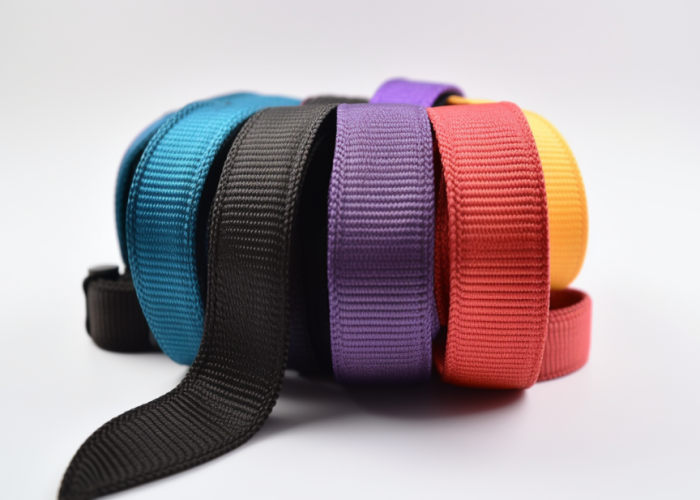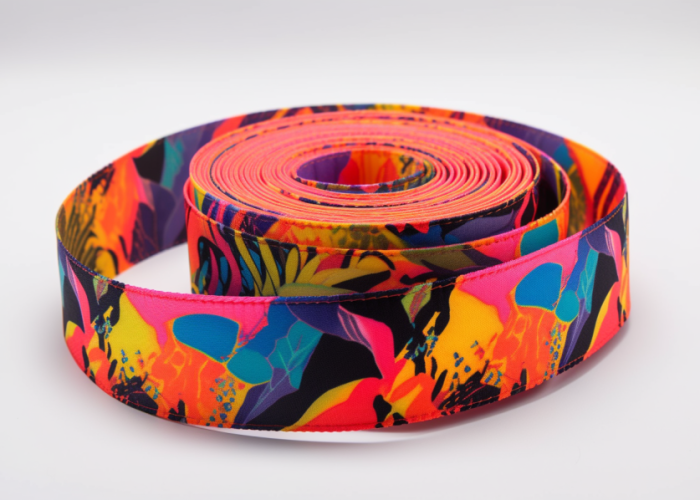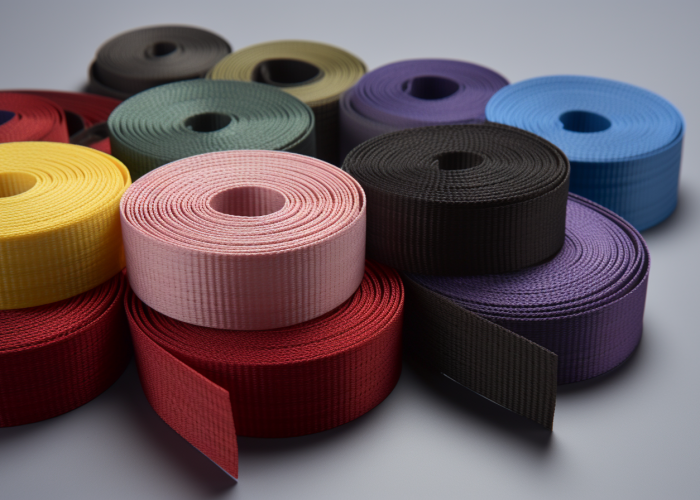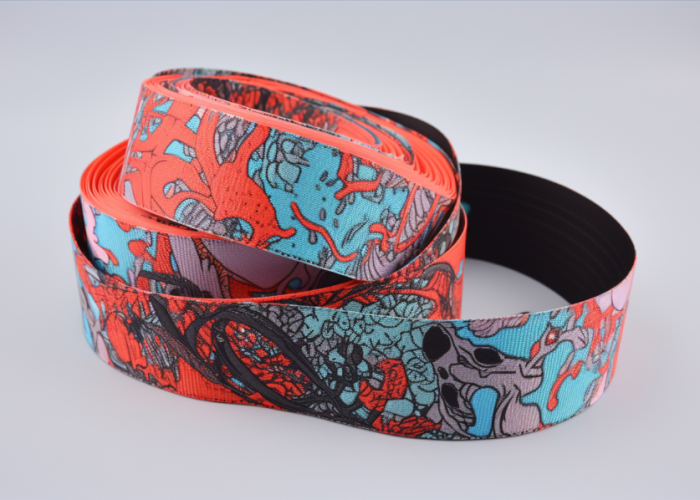Selecting the optimal webbing thickness is a critical decision that significantly impacts printing quality and performance across various applications. Understanding the relationship between webbing thickness and printing method ensures superior color reproduction, adequate durability, and consistent results that meet precise specifications for your custom projects.
Sublimation and heat transfer printing require 0.5-0.8mm thickness webbing, while direct-to-garment printing performs best with thinner 0.2-0.3mm webbing. Medium-thickness options (0.3-0.5mm) generally provide the optimal balance between vibrant colors and durability for most applications.
Learn how webbing thickness impacts printing performance and discover expert tips for selecting the ideal thickness for your application needs.


Webbing manufacturing expert with 15+ years of experience helping product developers build high-performance straps for industrial, medical, and outdoor use.
The best webbing thickness for sublimation printing ranges from 0.5mm to 0.8mm, as this thickness provides optimal ink absorption while maintaining sufficient durability. This range allows the dye sublimation process to effectively penetrate the polyester fibers while ensuring the webbing remains structurally sound after heat application.
Sublimation printing works by applying heat to transfer dye from a carrier medium onto polyester webbing. The process requires precisely controlled thickness to achieve ideal results. When working with thinner webbing below 0.5mm, the material may not provide sufficient depth for proper dye penetration, resulting in less vibrant colors. Conversely, webbing thicker than 0.8mm often requires excessive heat to achieve dye transfer throughout the material, which can compromise structural integrity.
The 0.5-0.8mm thickness range is particularly well-suited for sublimation because it creates an ideal balance between surface area and fiber density. This allows the dye to properly disperse throughout the material while maintaining color consistency. During the sublimation process, the dye transitions directly from a solid state to a gas, then permeates the polyester fibers before cooling and returning to a solid state. The recommended thickness ensures this process occurs evenly without requiring extreme temperature adjustments.
For thicker webbing (approaching 0.8mm), temperature settings can be adjusted to achieve complete dye penetration. This helps overcome the increased density of thicker materials, allowing the sublimation dye to properly gasify and bond with the polyester fibers while preserving the webbing structure.
When selecting webbing for sublimation printing, consider that thinner options within this range (0.5-0.6mm) typically produce more vibrant results but may sacrifice some durability. Meanwhile, thicker options (0.7-0.8mm) provide enhanced strength for applications requiring higher tensile performance but may require additional processing accommodations to achieve equivalent color saturation.
Webbing thickness of 0.2mm to 0.3mm works best for direct-to-garment printing, allowing for uniform ink application and optimal surface coverage. This thinner profile creates an ideal printing surface for DTG methods where ink is applied directly to the webbing surface rather than through heat transfer processes.
Direct-to-garment printing fundamentally differs from sublimation in how ink interacts with the substrate. Instead of relying on heat to convert dye into gas that permeates fibers, DTG printing deposits ink directly onto the surface of the webbing. The thinner 0.2-0.3mm webbing provides several distinct advantages for this process.
The reduced thickness creates a more even surface with less depth variation, which translates to more consistent ink coverage. The thinner profile allows the printing heads to maintain optimal distance from the entire printing surface, preventing issues with ink pooling or uneven application that can occur with thicker materials.
Additionally, this thickness range is ideal for absorbing the precise amount of ink required for vibrant DTG printing. Thicker webbing can absorb excessive ink, causing colors to appear less defined and potentially creating issues with drying time. The recommended thickness absorbs just enough ink to create vibrant prints without oversaturation.
The reduced thickness also contributes to faster drying times after printing, which is particularly important for production efficiency. Thicker webbing often requires extended drying periods that can slow manufacturing processes and potentially lead to smudging or bleeding of colors if handled too soon.
For products requiring both thin webbing for print quality and enhanced durability, special coating or finishing processes can reinforce the printed surface without compromising the print quality advantages of the thinner material.

Webbing thickness directly impacts print vibrancy by affecting ink absorption, color depth, and surface texture quality. Medium-thickness webbing (0.3-0.5mm) typically provides the optimal balance for vibrant prints, combining sufficient material for ink penetration with appropriate surface characteristics for color reproduction.
The relationship between thickness and vibrancy stems primarily from how ink interacts with the webbing substrate. Thinner webbing often lacks sufficient depth for proper ink absorption, resulting in colors that may appear flat or inconsistent. The limited fiber volume in very thin webbing provides less surface area for the ink to bond with, potentially reducing color saturation and depth.
Conversely, excessively thick webbing presents different challenges for print vibrancy. When webbing exceeds 0.7mm, ink may not penetrate thoroughly throughout the material, creating uneven color distribution. This is particularly important for applications where the webbing will be viewed from multiple angles or subjected to bending, as thicker materials with surface-only printing may show inconsistencies when flexed.
Surface texture, which varies with thickness, plays a crucial role in print vibrancy. Medium-thickness webbing typically offers the smoothest surface, which is ideal for detailed printing. The moderate density of fibers creates a more uniform surface for ink application while still allowing proper absorption. This smooth, even texture is particularly important for reproducing fine details and gradients in printed designs.
Another key factor is how thickness influences heat dispersion during printing processes that require thermal activation. Medium-thickness webbing provides ideal thermal properties—not so thin that heat passes through too quickly, nor so thick that heat fails to penetrate adequately. This balanced heat retention ensures dyes activate properly for maximum vibrancy.
For applications where maximum vibrancy is the primary concern, the optimal thickness generally falls between 0.3-0.5mm. This range allows for proper ink absorption while maintaining the surface qualities necessary for vibrant color reproduction. When other factors such as extreme durability or flexibility are also required, thickness selections may need to be adjusted accordingly, with modifications to the printing process to compensate for vibrancy effects.

Medium thickness webbing (0.3-0.5mm) provides the best print durability by balancing proper ink absorption with sufficient material structure. This optimal range ensures prints remain vibrant and resistant to wear while maintaining the flexibility and strength needed for most applications.
Print durability depends on how well the ink becomes integrated with the webbing fibers rather than simply sitting on the surface. Medium-thickness webbing allows ink to penetrate to an ideal depth—not so shallow that it remains vulnerable to surface abrasion, but not so deep that the color becomes diluted or inconsistent. This proper integration is crucial for creating prints that withstand regular handling, friction, and environmental exposure.
The 0.3-0.5mm thickness range offers sufficient material density to support and protect the printed design. This provides structural reinforcement for the ink, helping to prevent cracking or flaking when the webbing is flexed or stretched. Thinner webbing often lacks this structural support, leaving prints vulnerable to damage during use, while thicker materials may create excessive rigidity that causes prints to crack when bent.
Environmental resistance is another critical aspect of print durability. Medium-thickness webbing typically demonstrates superior resistance to environmental factors such as UV exposure, humidity, and temperature fluctuations. The balanced fiber density protects the ink from these elements without trapping excessive moisture or heat that could accelerate degradation.
The printing method should be appropriately matched to the webbing thickness. For example, even within the optimal thickness range, sublimation printing generally creates more durable results on 0.4-0.5mm webbing, while direct surface printing methods may perform better on the thinner end of the range (0.3-0.4mm).
For maximum print durability, post-processing treatments can significantly enhance performance. Medium-thickness webbing accepts protective coatings most effectively, allowing for additional durability enhancements without compromising the appearance or flexibility of the final product.
Environmental conditions significantly impact printed webbing performance, with thickness directly influencing resistance to moisture, temperature, and UV exposure. Medium-thickness webbing (0.3-0.5mm) generally offers the best overall environmental resistance, while thinner and thicker options present distinct advantages and challenges in specific conditions.
Moisture interaction varies substantially based on webbing thickness. Thinner webbing (below 0.3mm) absorbs moisture more rapidly, which can cause dimensional changes and potentially affect print integrity during humidity fluctuations. Conversely, medium-thickness webbing demonstrates improved moisture resistance while avoiding the moisture-trapping issues that can occur with thicker materials, where prolonged dampness between fibers might lead to color degradation or mildew development.
Temperature fluctuations affect printed webbing differently based on thickness. Thinner webbing responds more quickly to temperature changes, which can cause rapid expansion and contraction that stresses print adhesion. Medium-thickness options provide better temperature stability, maintaining dimensional consistency across varying conditions. This stability is crucial for applications exposed to outdoor environments or shipping through different climate zones.
UV resistance presents another thickness-dependent factor. While the webbing material itself largely determines UV resistance, thickness impacts how quickly UV degradation progresses through the material. Medium-thickness webbing offers an optimal balance of UV protection without excessive weight or stiffness. For applications with high UV exposure, specialized UV-resistant formulations are available across various thickness ranges.
For applications with specific environmental challenges, finishing treatments can enhance performance regardless of thickness. Water-repellent coatings, UV inhibitors, and anti-microbial treatments can complement the inherent properties of different thickness profiles to achieve optimal performance in challenging environments.

Medium to thick webbing (0.5-0.7mm) is typically best for technical applications requiring both printed information and structural performance. This thickness range provides sufficient durability and load-bearing capacity while still accepting clear, legible printing for specifications, safety information, or branding.
Technical applications demand webbing that maintains dimensional stability under stress while displaying critical information. The recommended thickness range offers an ideal balance between print clarity and mechanical performance. At 0.5-0.7mm, the webbing has enough substance to support applied loads without excessive stretch that would distort printed elements, yet remains thin enough to accept detailed printing necessary for technical specifications.
When webbing serves dual purposes—both structural and informational—thickness selection becomes particularly critical. Thinner webbing might provide superior print detail but lacks the strength required for load-bearing applications. Conversely, ultra-thick webbing offers excellent strength but presents challenges for print clarity and legibility, particularly for fine details like measurement markings or safety ratings.
For applications requiring precise measurement information, such as lifting slings or tie-downs with load ratings, the 0.5-0.7mm range allows for clear numerical printing while providing the necessary strength. This thickness ensures that critical safety information remains legible throughout the product lifecycle, even with regular use and environmental exposure.
Manufacturing processes for technical applications must be carefully controlled when working with this thickness range. Heat settings for printing require precise calibration to achieve proper ink penetration without compromising the structural integrity of the webbing. Similarly, any coatings or treatments applied to enhance durability must be compatible with both the printed elements and the mechanical requirements of the application.
Appropriate testing ensures the chosen thickness meets both the informational and structural requirements of the specific use case. This includes accelerated aging tests to verify print legibility over time and mechanical testing to confirm load-bearing capacity meets specifications.

Webbing thickness directly impacts production consistency by influencing ink absorption rates, heat transfer efficiency, and processing requirements. Medium-thickness webbing (0.3-0.5mm) typically provides the most consistent results across production runs, minimizing variations in print quality and performance.
Consistent production outcomes depend heavily on predictable material behavior during printing processes. Medium-thickness webbing offers optimal consistency because it responds more uniformly to printing parameters than extreme thickness options. This translates to fewer adjustments between production runs and more reliable color reproduction across large orders.
Ink absorption consistency is particularly thickness-dependent. Very thin webbing (below 0.2mm) can experience rapid and sometimes unpredictable ink absorption that varies based on minor material inconsistencies. Conversely, thicker webbing (above 0.7mm) may require significantly different ink formulations or application methods to achieve consistent results. The medium range balances these extremes, providing predictable ink interaction that minimizes batch-to-batch variation.
Heat transfer consistency, crucial for sublimation and heat-set processes, also varies with thickness. Medium-thickness webbing conducts heat at rates that are both efficient and predictable, allowing for consistent dye activation across the material. This reduces the occurrence of uneven coloration or pattern inconsistencies that can plague production runs using materials at thickness extremes.
Production speed and efficiency are additional factors affected by thickness selection. Medium-thickness webbing typically processes at optimal speeds, avoiding the careful handling required for very thin materials or the extended drying/curing times necessary for thicker options. This operational efficiency contributes to more consistent results by reducing the variables introduced through prolonged processing.
The medium thickness range offers additional advantages in quality control. The material provides sufficient substance for effective testing and inspection while maintaining properties that facilitate consistent production processes. This enables implementation of standardized quality assurance protocols that can be reliably applied across multiple production runs.
Selecting the appropriate webbing thickness is crucial for optimal printing results across different methods and applications. The right thickness balances print vibrancy, durability, and performance characteristics. We offer custom thickness solutions tailored to specific printing needs, material specifications, and environmental requirements to help you achieve superior results for your branded webbing products.
Heat transfer printing performs best on webbing between 0.5mm and 0.8mm thick. This range allows proper heat distribution and dye penetration during the transfer process. Thicker webbing within this range may require adjustments to temperature settings to ensure complete transfer.
Medium-thickness webbing between 0.3mm and 0.5mm delivers the most vibrant prints. This thickness provides optimal ink absorption without oversaturation while maintaining the ideal surface characteristics for accurate color reproduction and detail. We can customize thickness specifications to meet your exact vibrancy requirements.
Polyester webbing between 0.5mm and 0.8mm is optimal for sublimation printing. This thickness range provides sufficient depth for proper dye penetration while maintaining structural integrity during the heat application process. The ideal thickness within this range depends on your specific application requirements.
Webbing thickness directly impacts print vibrancy through its effect on ink absorption and surface texture. Medium-thickness webbing (0.3-0.5mm) typically delivers the most vibrant results by providing ideal ink penetration depth and surface smoothness for consistent color reproduction.
Medium-thickness webbing (0.3-0.5mm) typically provides the best print durability. This range allows ink to integrate properly with the fibers rather than sitting on the surface, creating a more wear-resistant bond. Thinner webbing often lacks structural support for the print, while thicker webbing may develop cracks when flexed.
Yes, different polyester webbing types have specific thickness recommendations based on their intended use. Decorative webbing works best at 0.2-0.5mm, while structural webbing with printed information performs better at 0.5-0.7mm. Technical applications with safety information require 0.5-0.7mm thickness for optimal print clarity and durability.